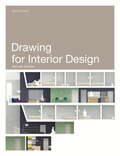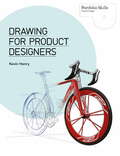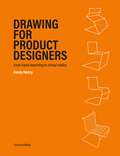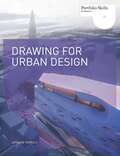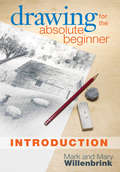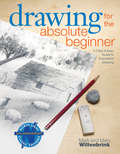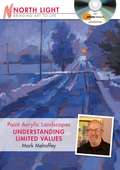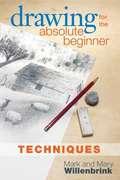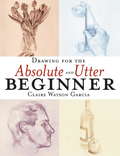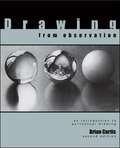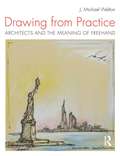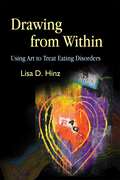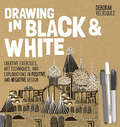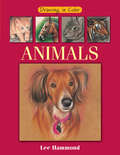- Table View
- List View
Drawing for Interior Design
by Drew PlunkettThis book covers all stages of visual presentation as part of the interior design process, from the most basic initial sketches, to models, to fully developed computer-generated visualizations. In four chapters this easy-to-follow text explains the basics, conception, presentation and production. With a varied and comprehensive range of images, this book is an invaluable, inspirational and practical resource for interior architecture and design students and practising interior designers alike.
Drawing for Interior Design (Portfolio Skills)
by Drew PlunkettThis book covers all stages of visual presentation as part of the interior design process, from the most basic initial sketches, to models, to fully developed computer-generated visualizations. In four chapters this easy-to-follow text explains the basics, conception, presentation and production. With a varied and comprehensive range of images, this book is an invaluable, inspirational and practical resource for interior architecture and design students and practising interior designers alike.
Drawing for Interior Design Second Edition
by Drew PlunkettThis book covers all stages of visual presentation as part of the interior design process, from the most basic initial sketches to fully developed computer-generated visualizations. Following a brief introduction four chapters take the reader through the design process, from the basics to conception, presentation and production. This second edition includes more practical advice on techniques, more case studies, step-by-step sequences and updated examples. With a varied and comprehensive range of images, this book is an invaluable, inspirational and practical resource for interior design students.
Drawing for Interior Design, 2nd edition
by Drew PlunkettThis book covers all stages of visual presentation as part of the interior design process, from the most basic initial sketches to fully developed computer-generated visualizations. Following a brief introduction four chapters take the reader through the design process, from the basics to conception, presentation and production. This second edition includes more practical advice on techniques, more case studies, step-by-step sequences and updated examples. With a varied and comprehensive range of images, this book is an invaluable, inspirational and practical resource for interior design students.
Drawing for Product Designers
by Kevin HenryWith its tutorial-based approach, this is a practical guide to both hand- and computer-drawn design. Readers will learn to think three-dimensionally and build complex design ideas that are structurally sound and visually clear.The book also illustrates how these basic skills underpin the use of computer-aided design and graphic software. While these applications assist the designer in creating physical products, architectural spaces and virtual interfaces, a basic knowledge of sketching and drawing allows the designer to fully exploit the software. Foundational chapters show how these technical skills fit into a deeper and more intuitive feeling for visualisation and representation, while featured case studies of leading designers, artists and architects illustrate the full range of different drawing options available.Hundreds of hand-drawn sketches and computer models have been specially created to demonstrate critical geometry and show how to build on basic forms and exploit principles of perspective to develop sketches into finished illustrations. There's also advice on establishing context, shading and realizing more complex forms.
Drawing for Product Designers (Portfolio Skills)
by Kevin HenryWith its tutorial-based approach, this is a practical guide to both hand- and computer-drawn design. Readers will learn to think three-dimensionally and build complex design ideas that are structurally sound and visually clear.The book also illustrates how these basic skills underpin the use of computer-aided design and graphic software. While these applications assist the designer in creating physical products, architectural spaces and virtual interfaces, a basic knowledge of sketching and drawing allows the designer to fully exploit the software. Foundational chapters show how these technical skills fit into a deeper and more intuitive feeling for visualisation and representation, while featured case studies of leading designers, artists and architects illustrate the full range of different drawing options available.Hundreds of hand-drawn sketches and computer models have been specially created to demonstrate critical geometry and show how to build on basic forms and exploit principles of perspective to develop sketches into finished illustrations. There's also advice on establishing context, shading and realizing more complex forms.
Drawing for Product Designers Second Edition: From Hand Sketching to Virtual Reality
by Kevin HenryDesigners do far more than visualize new products; they are called upon to imagine a future and bring it to life through visuals. Whether such futures begin as elaborate maps and diagrams of emerging technology or speculative "world-building," the contemporary designer's skill set must cover the entire spectrum, from abstract to representational, and from "low fidelity" to "high fidelity" visualizations.The advent of tablet-based sketching, VR sketching, and hybrids bring new and more intuitive ways of working. But confidence in manipulating lines, curves, and surfaces in space (whether flat, computer-assisted, or virtual) will remain a coveted skill regardless of where technology leads. In this practical guide to both hand-and computer-drawn design, essential principles are outlined so that readers will learn to think in 3D and build complex design ideas that are structurally sound and visually clear. Specially created sketches and computer models show how to develop rough sketches into finished illustrations, while also explaining how to select the right type of representation for the right purpose. This revised edition contains new material on sketching principles, working across platforms, and hybrid workflows. Also new to this edition: coverage of UX/UI design for smart devices and digital platforms, and information on cutting-edge technology such as AI tools and intuitive and collaborative VR sketching platforms. There are fifteen new case studies featuring work by leading designers, and a selection of videos further illuminate themes discussed in the book.List of chapters: The Sketching Spectrum Perspective Visual/Spatial Overview Orientation Registration Form Line Exploring Ideas in Space and Time Sketching and Storytelling
Drawing for Product Designers Second Edition: From Hand Sketching to Virtual Reality
by Kevin HenryDesigners do far more than visualize new products; they are called upon to imagine a future and bring it to life through visuals. Whether such futures begin as elaborate maps and diagrams of emerging technology or speculative "world-building," the contemporary designer's skill set must cover the entire spectrum, from abstract to representational, and from "low fidelity" to "high fidelity" visualizations.The advent of tablet-based sketching, VR sketching, and hybrids bring new and more intuitive ways of working. But confidence in manipulating lines, curves, and surfaces in space (whether flat, computer-assisted, or virtual) will remain a coveted skill regardless of where technology leads. In this practical guide to both hand-and computer-drawn design, essential principles are outlined so that readers will learn to think in 3D and build complex design ideas that are structurally sound and visually clear. Specially created sketches and computer models show how to develop rough sketches into finished illustrations, while also explaining how to select the right type of representation for the right purpose. This revised edition contains new material on sketching principles, working across platforms, and hybrid workflows. Also new to this edition: coverage of UX/UI design for smart devices and digital platforms, and information on cutting-edge technology such as AI tools and intuitive and collaborative VR sketching platforms. There are fifteen new case studies featuring work by leading designers, and a selection of videos further illuminate themes discussed in the book.List of chapters: The Sketching Spectrum Perspective Visual/Spatial Overview Orientation Registration Form Line Exploring Ideas in Space and Time Sketching and Storytelling
Drawing for Urban Design
by Lorraine FarrellyArchitects and urban planners need to describe cities in the course of their work, be it through maps, diagrams, sketches, computer renderings or models. Drawing for Urban Design explores a wide range of ways to represent the city, from freehand sketching to sophisticated computer models. The book provides a practical introduction to these techniques for students while explaining the processes associated with describing and designing urban environments – it is an invaluable visual handbook for representing the contemporary city.
Drawing for Urban Design (Portfolio Skills)
by Lorraine FarrellyArchitects and urban planners need to describe cities in the course of their work, be it through maps, diagrams, sketches, computer renderings or models. Drawing for Urban Design explores a wide range of ways to represent the city, from freehand sketching to sophisticated computer models. The book provides a practical introduction to these techniques for students while explaining the processes associated with describing and designing urban environments – it is an invaluable visual handbook for representing the contemporary city.
Drawing for the Absolute Beginner, Composition
by Mark WillenbrinkThis e-book contains nine detailed step-by-step demonstrations on composition, texture, perspective and storytelling and includes a glossary of common art terms. It is based on Drawing for the Absolute Beginner (North Light 2006) by Mark and Mary Willenbrink.
Drawing for the Absolute Beginner, Introduction
by Mark WillenbrinkYou won't be disappointed with the basic instruction based on the popular print book Drawing for the Absolute Beginner (North Light 2006) by Mark and Mary Willenbrink. Learn all you need to know about getting started sketching and drawing including materials, basic techniques and perspective. Also includes a glossary of common art terms. The Absolute Beginner series of e-books will inspire anyone who wants to make art to create realistic artwork for any subject, including still life, landscapes, animals and people.
Drawing for the Absolute Beginner, Techniques
by Mark WillenbrinkYou won't be disappointed with the basic instruction based on the popular print book Drawing for the Absolute Beginner (North Light 2006) by Mark and Mary Willenbrink. Learn all about value and shadows, and get more than 15 step-by-step technique exercises on how to draw still lifes, animals and people. Also includes a glossary of common art terms. The Absolute Beginner series of e-books will inspire anyone who wants to make art to create realistic artwork for any subject, including still life, landscapes, animals and people.
Drawing for the Absolute Beginner: A Clear & Easy Guide to Successful Drawing (Art for the Absolute Beginner)
by Mary Willenbrink Mark WillenbrinkThis inspiring book makes drawing in a realistic style easier than you may think and more fun than you ever imagined! Authors Mark and Mary Willenbrink (Watercolor for the Absolute Beginner) cover it all-from choosing materials and the correct way to hold your pencil, to expert advice on the tricky stuff, like getting proportions and perspective right, drawing reflections, and designing strong compositions. (It's not as scary as it sounds...not with Mark and Mary as your guide!) At the heart of this book, a series of fun, hands-on exercises help you practice and perfect your strokes-24 mini-demos lead up to 9 full step-by-step demos. Each exercise builds on the previous one as you develop your skills, build your confidence, and enjoy yourself along the way. The lessons you learn by drawing simple subjects such as coffee mugs, clouds and trees will help you take on progressively more challenging matter like animals, still lifes, landscapes and portraits...the kinds of subjects and scenes you've always dreamt of drawing. This book is just the ticket for budding artists of any age. It's never too early and never too late to discover the pure joy of drawing!
Drawing for the Absolute Beginner: Composition
by Mark Mary WillenbrinkThis eBook contains 9 detailed step-by-step demonstrations on composition, texture, perspective and storytelling and includes a glossary of common art terms. It is based on Drawing for the Absolute Beginner (North Light 2006) by Mark and Mary Willenbrink
Drawing for the Absolute Beginner: Introduction
by Mark Mary WillenbrinkYou won't be disappointed with the basic instruction based on the popular print book Drawing for the Absolute Beginner (North Light 2006) by Mark and Mary Willenbrink. Learn all you need to know about getting started sketching and drawing including materials, basic techniques and perspective. Also includes a glossary of common art terms. The Absolute Beginner series of eBooks will inspire anyone who wants to make art to create realistic artwork for any subject, including still life, landscapes, animals and people.
Drawing for the Absolute Beginner: Techniques
by Mark Mary WillenbrinkYou won't be disappointed with the basic instruction based on the popular print book Drawing for the Absolute Beginner (North Light 2006) by Mark and Mary Willenbrink. Learn all about value and shadows, and get more than 15 step-by-step technique exercises on how to draw still lifes, animals and people. Also includes a glossary of common art terms. The Absolute Beginner series of eBooks will inspire anyone who wants to make art to create realistic artwork for any subject, including still life, landscapes, animals and people.
Drawing for the Absolute and Utter Beginner
by Claire Watson GarciaBased upon the author's own successful workshops, Drawing for the Absolute and Utter Beginner helps new artists create competent, often eloquent drawings. A series of progressive lessons demonstrates such essential skills as recording edges, creating dimension, adding accuracy, developing value, balancing compositional elements, and drawing the human face, both frontal and profile views. Step by step, readers learn how to create a reasonable likeness of an object and give it spatial depth using such simple black-and-white mediums as pens, pencils, charcoal, and graphite wash. Inspirational examples and tips for success from beginning students who have worked on the same material confirm readers' successes, and allow readers to consider the advice and impressions of others at the same level.
Drawing for the Absolute and Utter Beginner, Revised: 15th Anniversary Edition
by Claire Watson GarciaThis revised 15th anniversary edition of the bestselling beginning drawing book updates art and text examples to include new student pieces, up-to-date materials, and additional sections on drawing in 3D and travel sketching, along with refreshed and contemporary design.Based on author and art instructor Claire Watson Garcia's successful courses and workshops for beginning and aspiring artists, Drawing for the Absolute and Utter Beginner applies a positive, accepting tone to a progressive series of lessons in sketching and rendering. The book's step-by-step methodology and examples of student works from earliest efforts to completed drawings give novices the tools and techniques needed to make competent and eloquent renderings of still lifes, portraits, and more. In this revised edition, Garcia covers such in-demand subject matter as drawing-on-the-go, drawing in three dimensions, and drawing the portrait at a three-quarter view. The reinvigorated art and text ensure that this drawing instruction classic will continue to appeal to new generations of aspiring artists.
Drawing from Observation: An Introduction to Perceptual Drawing
by Brian CurtisPerceptual drawing, in which one renders the physical world as it appears to an observer, is the focus of this new text for the introductory drawing course. With an emphasis on progressive skill development, Drawing from Observation offers a balanced mix of hands-on technique and perceptual theory while making a compelling argument for the long-term value of studying perception-based drawing.
Drawing from Practice: Architects and the Meaning of Freehand
by J. Michael WeltonDrawing from Practice explores and illuminates the ways that 26 diverse and reputable architects use freehand drawing to shape our built environment. Author J. Michael Welton traces the tactile sketch, from initial parti to finished product, through words, images, and photographs that reveal the creative process in action. The book features drawings and architecture from every generation practicing today, including Aidlin Darling Design, Alberto Alfonso, Deborah Berke, Marlon Blackwell, Peter Bohlin, Warren Byrd, Ellen Cassilly, Jim Cutler, Chad Everhart, Formwork, Phil Freelon, Michael Graves, Frank Harmon, Eric Howeler and Meejin Yoon, Leon Krier, Tom Kundig, Daniel Libeskind, Brian McKay Lyons, Richard Meier, Bill Pedersen, Suchi Reddy, Witold Rybczynski, in situ studio, Laurinda Spear, Stanley Tigerman, and Tod Williams Billie Tsien Architects. Included is a foreword by Robert McCarter, architect, author and professor of architecture.
Drawing from Within: Using Art to Treat Eating Disorders
by Lisa HinzDrawing from Within is an introductory guide for those wanting to explore the use of art with clients with eating disorders. Art therapy is a particularly effective therapeutic intervention for this group, as it allows them to express uncomfortable thoughts and feelings through artistic media rather than having to explain them verbally. Lisa D. Hinz outlines the areas around which the therapist can design effective treatment programmes, covering family influences, body image, self-acceptance, problem solving and spirituality. Each area is discussed in a separate chapter and is accompanied by suggestions for exercises, with advice on materials to use and how to implement them. Case examples show how a therapy programme can be tailored to the individual client and photographs of client artwork illustrate the text throughout. Practical and accessible to practitioners at all levels of experience, this book gives new hope to therapists and other mental health professionals who want to explore the potential of using art with clients with eating disorders.
Drawing from the Model: Fundamentals of Digital Drawing, 3D Modeling, and Visual Programming in Architectural Design
by Frank MelendezBridges traditional and contemporary methods of creating architectural design drawings and 3D models through digital tools and computational processes. Drawing from the Model: Fundamentals of Digital Drawing, 3D Modeling, and Visual Programming in Architectural Design presents architectural design students, educators, and professionals with a broad overview of traditional and contemporary architectural representation methods. The book offers insights into developments in computing in relation to architectural drawing and modeling, by addressing historical analog methods of architectural drawing based on descriptive geometry and projection, and transitioning to contemporary digital methods based on computational processes and emerging technologies. Drawing from the Model offers digital tools, techniques, and workflows for producing architectural design drawings (plans, sections, elevations, axonometrics, and perspectives), using contemporary 2D drawing and 3D modeling design software. Visual programming is introduced to address topics of parametric modeling, algorithmic design, computational simulations, physical computing, and robotics. The book focuses on digital design software used in higher education and industry, including Robert McNeel & Associates Rhinoceros® (Rhino 6 for Windows), Grasshopper®, Adobe Illustrator® CC, and Arduino, and features an appendix filled with 10 design drawing and 3D modeling exercises intended as educational and pedagogical examples for readers to practice and/or teach workflows that are addresses in the book. Bridges analog hand-drawing and digital design drawing techniques Provides comprehensive coverage of architectural representation, computing, computer-aided drafting, and 3D modeling tools, techniques, and workflows, for contemporary architectural design drawing aesthetics and graphics. Introduces topics of parametric modeling, algorithmic design, computational simulation, physical computing, and robotics through visual programming environments and processes. Features tutorial-based instruction using the latest versions of Rhinoceros® (Rhino 6 for Windows), Grasshopper®, Adobe Illustrator® CC, and Arduino.
Drawing in Black & White: Creative Exercises, Art Techniques, and Explorations in Positive and Negative Design
by Deborah Velasquez&“The style of this book is loose and easy, about having fun, and learning to work within the confines of black and white rather than depending on color.&” —Art Elements Working with only positive and negative lines and shapes keeps the focus on the basics: composition, balance, and harmony. And using white and black gel, ink, and paint pens on black, tan, and gray papers allows you to experience drawing in a whole new way! Drawing in Black & White is a clever drawing and design book that contains 36 inspiring exercises and a gallery of artwork. Follow the tips and draw on black, gray, and tan paper to learn how different colored papers can make simple images pop. You&’ll find lessons on drawing, pattern drawing, drawing with cut paper, and simple collage. Learn to see your drawings a new way by drawing in black and white! &“While confined to only two colors, black and white, this guide&’s techniques, materials, and tools are not nearly so limited . . . Readers with some experience drawing and painting are the best audience for this guide, but there is plenty here for beginners and advanced artists, too.&” —Library Journal &“The goal of the book is to let you be familiar with black and white media, to draw and have fun . . . It&’s a fun activity book for those who want to dabble with art.&” —Parka Blogs
Drawing in Color ANIMALS: Animals (Drawing in Color)
by Lee HammondHammond's easy-to-follow techniques enable even first-time artists to render a variety of wonderful animals, from cats and dogs to horses, squirrels, tigers and more.

